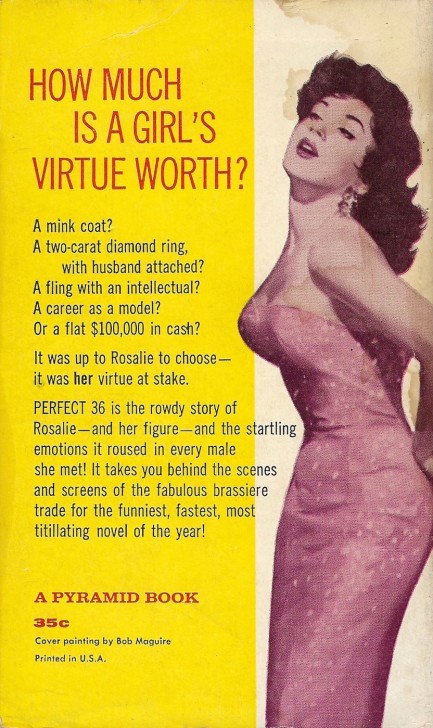 You don't mind if I keep the blinds up, do you? The guys in the building across the street like to watch. 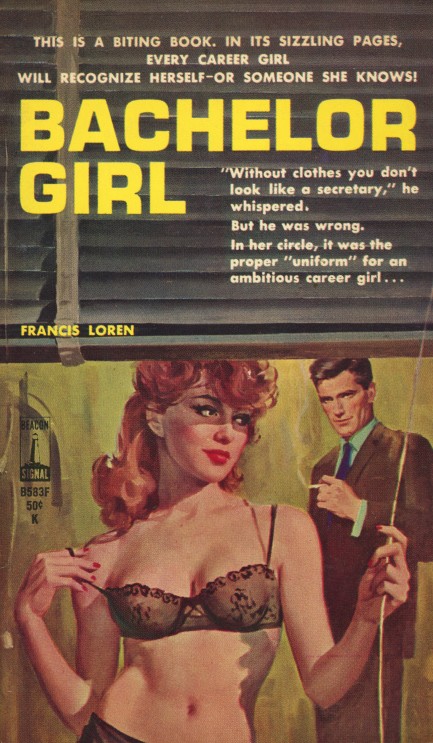
Above: a cover for the 1963 novel Bachelor Girl by Francis Loren. This was painted by acknowledged master Robert Maguire. As for Loren, we'll soon find out about him. We have one of his novels on deck. We've put together a couple of collections of covers featuring Venetian blinds. You can see those here and here.
 Symons reflects on exactly how bad a man's life can be. 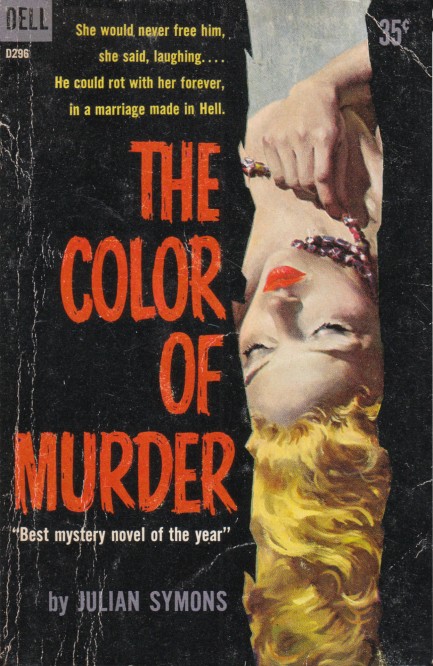
Looking for a bit more depth in your murder mysteries? 1957's The Color of Murder by British author Julian Symons takes a literary approach to the genre, examining the torturous existence of sad sack office drone John Wilkins, who hates his wife, covets the neighborhood librarian, and suffers from blackouts at times of stress (uh oh). Symons divides the novel roughly in half. In the first, Wilkins explains in first person to a psychologist how he came to be mired in a terrible life and loveless marriage, his account stopping before the murder (which if he actually committed, he'd presumably have blacked out anyway). The second half follows in third person the course of Wilkins' trial, with assorted twists, and there's an epilogue providing final focus. Whether or not Wilkins is a killer, he's a pitiable human. If you think you have an unsatisfactory life, read The Color of Murder to learn how well-off you really are. The cover art on this Dell edition is by Robert Maguire.
 I can see the forest for the trees just fine. What I can't see is how you got us lost. 
Above: Robert Maguire art for Conrad Richters's 1940 novel The Trees, which Bantam Books issued in this paperback edition in 1951. This was a serious novel, the first in an Ohio frontier trilogy known as The Awakening Land. The third novel, The Town, won Richter a Pulitzer Prize in 1951, which may have precipitated Bantam's pulpy re-issue. This isn't one we'll read, but we do like the art.
 Hmph. That actually turned out to be a surprisingly easy choice. 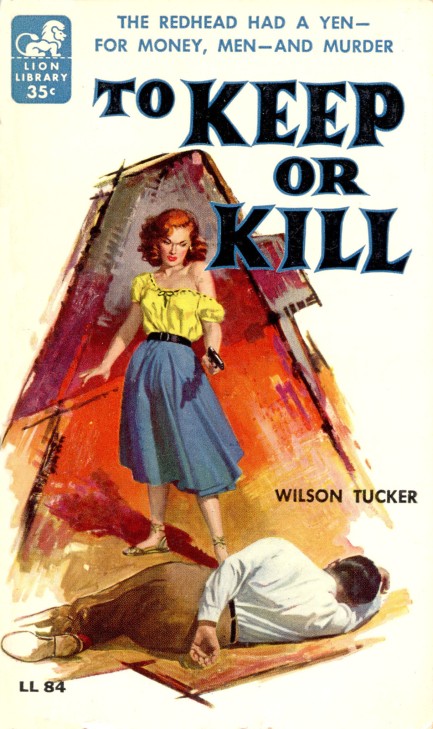
Above: nice Robert Maguire art for Wilson Tucker's novel To Keep or Kill, from Lion Library, 1956. Tucker was primarily a science fiction writer, an acclaimed one, who invented the practice and term, “tuckerization,” which is to borrow a friend's name for a fictional character. This is not to be confused with actually basing a character on a friend. Tuckerization is sort of an in-joke, a nod to someone in one's social circle. Turning back to the cover, this fits nicely into our collections of women who've killed or mortally wounded men, which you can see here and here.
 Some actresses consider it a role to die for—literally. 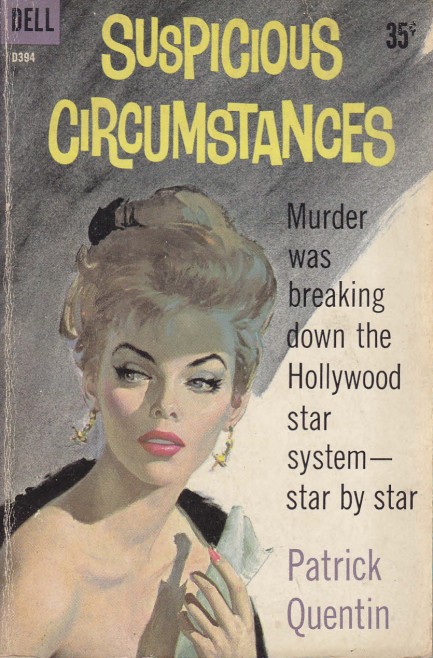
This is a beautiful Robert Maguire cover, somewhat different from his normal style, that he painted for Patrick Quentin's 1957 mystery Suspicious Circumstances. Quentin was a pseudonym used by various authors, but in this case Hugh Wheeler was behind the façade. The cover blurb describes murder breaking down the Hollywood star system, and that's basically what you get, as the book centers around nineteen-year-old Nick Rood, nervous son of globally adored actress Anny Rood, and follows his suspicions that his mother has killed in order to steal a plum movie role. The book is written in amusing and affected fashion, and is filled with characters speaking in ways no humans do, or likely ever did:
“It's positively Greek. Sophocles would purr. Aeschylus would run not walk to the nearest papyrus or whatever he wrote on.”
How very arch. Thanks to various crises, third party manipulations, and suspicious deaths, the coveted film role repeatedly falls into and out of Anny Rood's lap, while fragile Nick flips and flops from suspecting his mother of murder to not. Meanwhile a newcomer to the entourage, a young secretary named Delight Schmidt, turns Nick's head with her beauty and sweetness, but may be just ambitious enough to have a hand in everything that's occurring. Mid-century authors seem addicted to portraying Hollywood in comical or farcical fashion, but we can't argue with the results here. Suspicious Circumstances is well written, generally interesting, and occasionally funny as hell.
 Honey! Oh no! There goes your undefeated record! And in your very first fight! 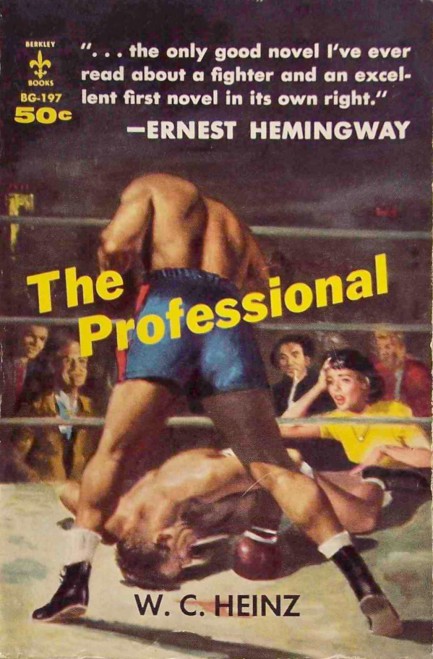
This 1959 Berkley Books edition of the 1958 W.C. Heinz boxing novel The Professional has excellent Robert Maguire cover art of a boxer on the deck and a distressed woman looking on in horror. You'll also notice Ernest Hemingway's endorsement. Papa's fame led to his stamp of approval being highly coveted. We'd guess we've seen his name used this way on ten covers, but we bet there are more. If you go by the reviews on this book, Heinz deserved all the praise he received for his tale of a middle-weight boxer trying to climb to the top. As an award winning sports writer he knew his stuff, and he collected other accolades to go with his anointment by Hemingway, winning the E. P. Dutton Award for best magazine story of the year five times, and earning the A. J. Liebling Award for boxing writing. Over the decades Heinz had his work reprinted in dozens of anthologies and textbooks, so if you're into sports journalism he's one of the main dudes. We have a fair number of boxing covers in our website, and they tend to be amusing if you look at them just the right way. We won't link to them all, but if you want to see some good examples try here, here, here, here, here, and here.
 This is nothing. When I get really mad I grow to enormous size and destroy entire city blocks. 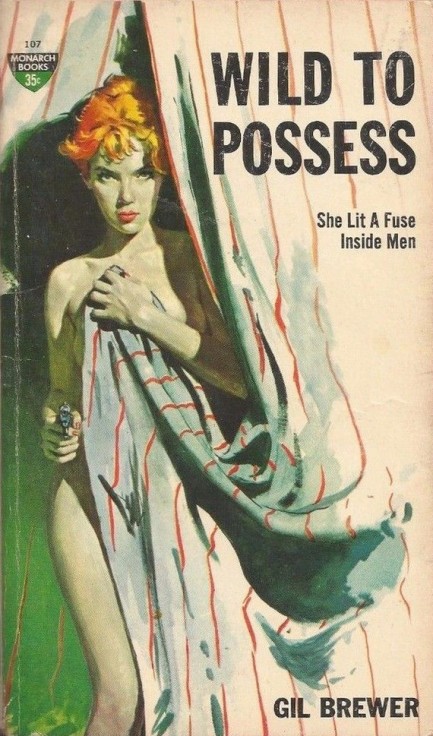
There's getting into trouble, getting into serious trouble, and getting into ridiculous trouble. In Gil Brewer's 1959 thriller Wild To Possess, the main character Lew Brookbank finds his wife and her lover murdered, and, thinking he might get blamed, panics and disposes of the bodies. Trouble. Later he overhears two people plotting a kidnapping and murder and decides that if he robs them of the two-hundred-fifty grand they expect to profit he can start a new life. But he's a drunk, so signs don't point to success. Serious trouble. Then a man turns up determined to send Lew to the electric chair for the two murders he never committed. Ridiculous trouble.
In an effort to make this loony plot believable Brewer shuffles the timeline: it opens with Lew overhearing the pair talking about the kidnap/murder, then the narrative backtracks and reveals that his wife's murder is why he became an alcoholic basket case. It actually works, sort of, which is good, because bizarre things keep happening, some of which involve a trapdoor above his bed. We won't even explain it. This is mid-level Brewer, quality-wise. While it has some fun ideas, it could have used extra detailing from a dedicated editor. But it's worth a read, especially this Monarch edition with iconic Robert Maguire cover art of an orange-topped, Hulk green femme fatale. More Gil to come.
 Thompson's Town is the craziest patch of real estate west of the Potomac River. 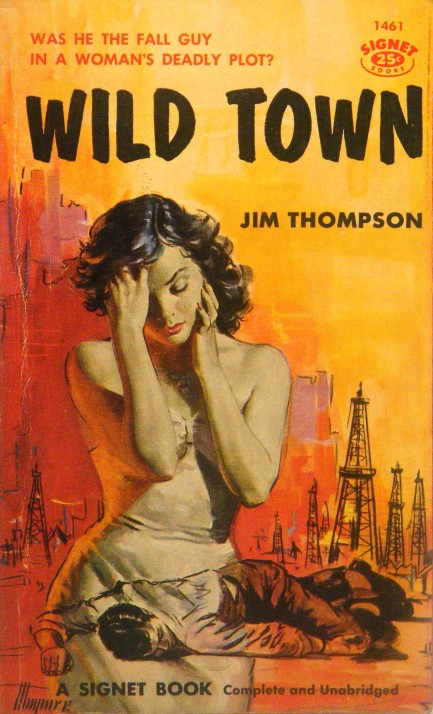
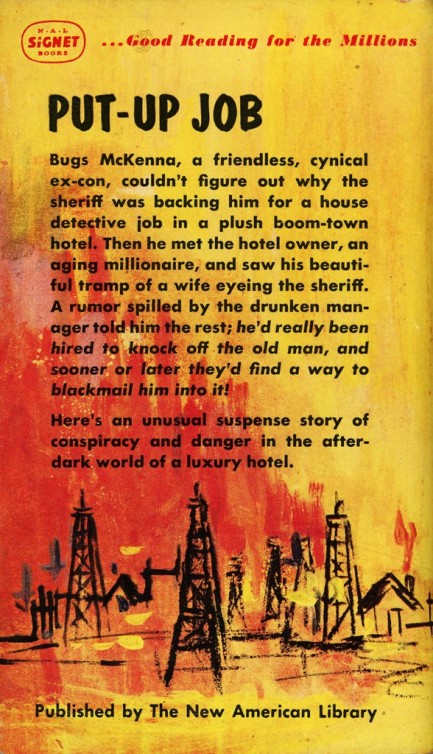 Robert Maguire handled the cover work on this edition of Jim Thompson's Wild Town, which hit book racks in 1957. The pricing on this varies greatly. All we can say is please don't pay $450.00 for it, like one vendor was recently asking. We got ours—the same edition—for $15. Robert Maguire handled the cover work on this edition of Jim Thompson's Wild Town, which hit book racks in 1957. The pricing on this varies greatly. All we can say is please don't pay $450.00 for it, like one vendor was recently asking. We got ours—the same edition—for $15.
Set in the fictional boomtown of Ragtown, Texas, the tale's hard luck ex-con anti-hero Bugs McKenna lands a job as a hotel detective, but he's been funnelled into the position by the corrupt local deputy, apparently to serve nefarious—though unknown—ends. Is he to spy on the hotel owner? Participate in some shady plot involving a guest? Murder somebody? It could be anything, because the deputy who orchestrated the hiring is none other than Lou Ford, the main character of Thompson's 1952 tour de force The Killer Inside Me. If you haven't read it, long story short, he's a psychopath.
Trouble doubles when Bugs accidentally karate chops the hotel accountant out a window. The death was unwitnessed and is ruled a suicide—for the moment. Ford suspects foul play, but Bugs feels in the clear. Then someone starts to blackmail him, someone who says they were in the closet and saw the killing. Who is the blackmailer? Can Bugs outwit them somehow? He isn't that bright—a type Thompson specialized at writing—so his efforts to manage his difficulties are haphazard at best.
But maybe Bugs is brighter than he seems. He'll need to be, pitted as he is against Thompson's iconic Lou Ford, but in the end a woman may turn out to be his direst foe. That's not a spoiler—the cover text suggests that a femme fatale is pulling the strings, but even Bugs doesn't know who because he spends the book troubled by three. All of this makes for plenty of reading fun. Wild Town is no Pop. 1280—our favorite Thompson so far—but it's diverting enough. Another recommended effort from a deft architect of chaos and criminality.
 She used the oldest game to become the newest player. 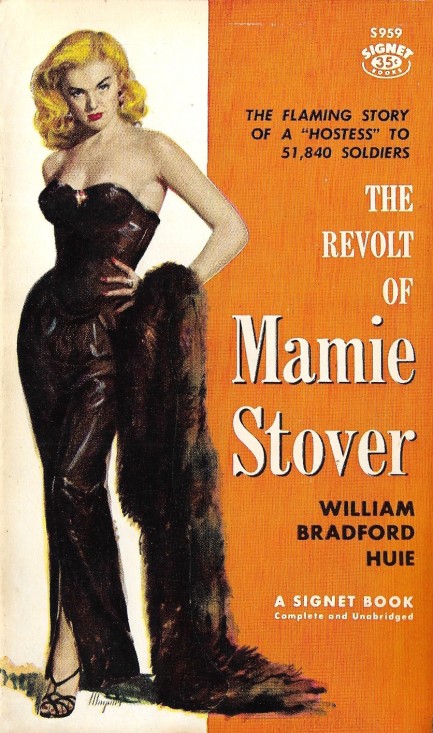
Once again art makes the sale, as we bought this copy of The Revolt of Mamie Stover thanks to its Robert Maguire cover. The blonde femme fatale is of course the Mamie of the title, an aspiring actress run out of Hollywood upon threat of death and booked onto a freighter headed for Honolulu, there to descend into the oldest profession and become a famed wartime prostitute known as Flaming Mamie. The story details her efforts to earn a mint, procure for herself a piece of Honolulu, and buy her way to respectability against terrific opposition from Oahu's Anglo bluebloods.
But there was something about the book that we couldn't put a finger on at first. If we'd read it in 1951 when it was originally published, it might have been clearer, we figured, but as it stood we weren't sure what underlying point Huie was trying to make until halfway through, when—aha!—we realized The Revolt of Mamie Stover is an allegory for the liberal assault against old world American values. At least that's the conclusion we reached. Just to be sure we double-checked on the internet and—aha!—allegory, liberal assault, and so forth.
However, like certain other mid-century novelists considered to be sociologically incisive at the time, Huie was working from incomplete information. The worth, order, and ever escalating prosperity he suggests industrious white men created out of primitive chaos are ending with a whimper under the assaults of climate change, soil depletion, de-industrialization, species extinction, tax evasion, unregulated financial speculation, and cynical war. Raping nature is simply a counterproductive enterprise. The science on that is settled. Trickle down economics don't trickle. That's settled too. Those industrious men built nothing that wasn't going to collapse anyway due to the laws of physics and corrupt economics.
But as we said, Huie couldn't have known that, so within his allegory America is going to hell in a handbasket due to the aforementioned liberal democratization. Or more to the point—give everyone equal rights, and the ungrateful bastards will actually use them to change things. Mamie Stover, barred from all the nice sectors of Honolulu because of her supposedly shameful profession, revolts against and smashes the prohibitions imprisoning her in second class citizenship—and as a result opens the door for native Hawaiians to burst their confines too and ruin whites-only Waikiki Beach.
Huie presents a choice between an orderly but racially repressive society and a disorderly democratic society, but he gets the reasons for disorder wrong. Disorder derives from deprivation, not democratization. Few people get bothered over what others achieve or possess if they feel themselves to be getting a fair shake. But make them feel they've been cheated and they'll assign blame. This is really what the industrious men figured out: the underclasses normally look upward for reasons their lives aren't improving, but it can be prevented if some of them can be made to feel they've been fucked over by others of them. If a racial element can be injected too, all the better. Once discord is established, even people who know better have to join the fight, if only to defend those unfairly under attack.
But while The Revolt of Mamie Stover is built around a moribund allegory, Mamie's personal story makes it a page turning book. You root for her—though it should noted she's no true protagonist. Huie gives readers a masterclass in racism, expressed repetitively and explicitly. Hawaiians, Japanese, Chinese, and other peoples you'd see around the islands are referred to mainly by slurs—not typical anti-Asian slurs, but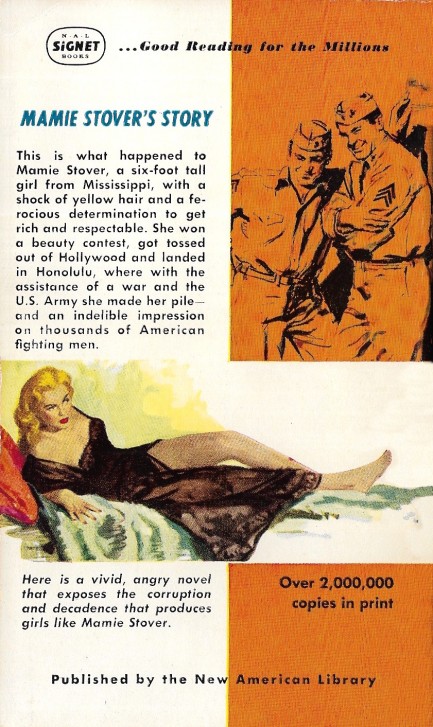 rather by that age-old slur for African Americans. Nice, right? It pops up, we'd estimate, fifty times in a short book. And Mamie is even more racist-mouthed than the rest. Once she gains access to the tony districts of town, she plans to punch down on all these undesirables. And she's going to enjoy it, she makes clear. She's prostituted herself to gain status—why should she care about anyone who wasn't willing to sacrifice as she did? rather by that age-old slur for African Americans. Nice, right? It pops up, we'd estimate, fifty times in a short book. And Mamie is even more racist-mouthed than the rest. Once she gains access to the tony districts of town, she plans to punch down on all these undesirables. And she's going to enjoy it, she makes clear. She's prostituted herself to gain status—why should she care about anyone who wasn't willing to sacrifice as she did?
A tale this ideological naturally makes you wonder what the author's personal beliefs were. Huie was complicated. While working as a journalist he involved himself in one of the most infamous racist murders of his era, and not in a good way. But he counted among his acquaintances Zora Neale Hurston and Roy Wilkins. He was probably not a bigot by 1950s standards, but in writing about class and race he was uncompromising, and his foundational assumptions about society were wrong. He could have written The Revolt of Mamie Stover with far less ugliness and it would have worked fine, but that never would have occurred to him. He saw ugly realism and reflected it. In that way he was a true writer. Before you read the book—if indeed you do—you'll have to consider that.
 Ed Spingarn takes readers on a bumpy ride down mammary lane. 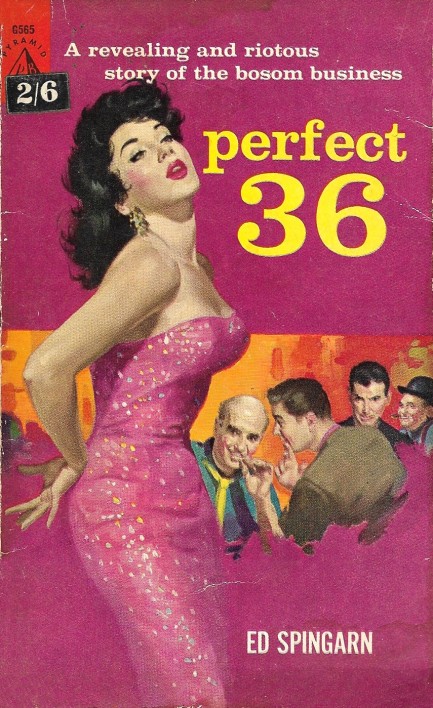
Robert Maguire painted the cover for Ed Spingarn's 1957 novel Perfect 36, and came up with something beautiful and colorful that drew our eye. The tagline—A revealing and riotous story of the bosom business—did the rest of the sales job. The book tells the story of nineteen-year-old Rosalie Gershon, who's determined to make something of herself professionally, and, thanks to her outstanding figure, stumbles into the ladies undergarment business. Seems she's a perfect model for the newly created Brooklyn Bridge Bra, designed along architectural principles. Rosalie wants to succeed, but she's also a virgin with insistent hormones, and the high rolling fast talkers of the NYC fashion business are lining up to take her on her first mattress ride.
In other words, what you have here is a virtue-in-danger novel, but one that's better than most. Will Rosalie give in, and if so to whom? The poor but sincere co-worker? The business mogul's slick son? The rich man who offers her mink coats? Everybody wants her and they'll play dirty to get her. Only in fiction is it so difficult being gorgeous. As the plot develops, Rosalie's virginity—actually her possible lack of it—becomes worth potentially $100,000. It's an unlikely twist, and Rosalie's an unlikely character, but Spingarn manages to make her sympathetic, and he does it by using high quality literary skills and (we suspect) inside knowledge of the fashion industry. We'd read him again, for sure, but unfortunately Perfect 36 seems to be the only novel he ever wrote.

|
 |

The headlines that mattered yesteryear.
1923—Yankee Stadium Opens
In New York City, Yankee Stadium, home of Major League Baseball's New York Yankees, opens with the Yankees beating their eternal rivals the Boston Red Sox 4 to 1. The stadium, which is nicknamed The House that Ruth Built, sees the Yankees become the most successful franchise in baseball history. It is eventually replaced by a new Yankee Stadium and closes in September 2008. 1961—Bay of Pigs Invasion Is Launched
A group of CIA financed and trained Cuban refugees lands at the Bay of Pigs in southern Cuba with the aim of ousting Fidel Castro. However, the invasion fails badly and the result is embarrassment for U.S. president John F. Kennedy and a major boost in popularity for Fidel Castro, and also has the effect of pushing him toward the Soviet Union for protection. 1943—First LSD Trip Takes Place
Swiss scientist Albert Hofmann, while working at Sandoz Laboratories in Basel, accidentally absorbs lysergic acid diethylamide, better known as LSD, and thus discovers its psychedelic properties. He had first synthesized the substance five years earlier but hadn't been aware of its effects. He goes on to write scores of articles and books about his creation.
|

|
|

It's easy. We have an uploader that makes it a snap. Use it to submit your art, text, header, and subhead. Your post can be funny, serious, or anything in between, as long as it's vintage pulp. You'll get a byline and experience the fleeting pride of free authorship. We'll edit your post for typos, but the rest is up to you. Click here to give us your best shot.

|
|




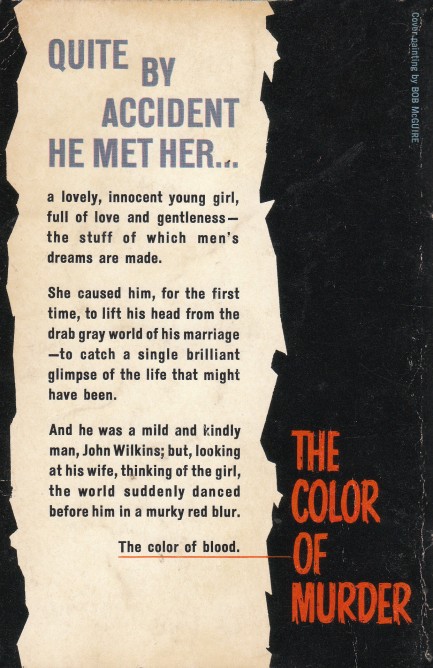












 Robert Maguire handled the cover work on this edition of Jim Thompson's Wild Town, which hit book racks in 1957. The pricing on this varies greatly. All we can say is please don't pay $450.00 for it, like one vendor was recently asking. We got ours—the same edition—for $15.
Robert Maguire handled the cover work on this edition of Jim Thompson's Wild Town, which hit book racks in 1957. The pricing on this varies greatly. All we can say is please don't pay $450.00 for it, like one vendor was recently asking. We got ours—the same edition—for $15.


 rather by that age-old slur for African Americans. Nice, right? It pops up, we'd estimate, fifty times in a short book. And Mamie is even more racist-mouthed than the rest. Once she gains access to the tony districts of town, she plans to punch down on all these undesirables. And she's going to enjoy it, she makes clear. She's prostituted herself to gain status—why should she care about anyone who wasn't willing to sacrifice as she did?
rather by that age-old slur for African Americans. Nice, right? It pops up, we'd estimate, fifty times in a short book. And Mamie is even more racist-mouthed than the rest. Once she gains access to the tony districts of town, she plans to punch down on all these undesirables. And she's going to enjoy it, she makes clear. She's prostituted herself to gain status—why should she care about anyone who wasn't willing to sacrifice as she did?

